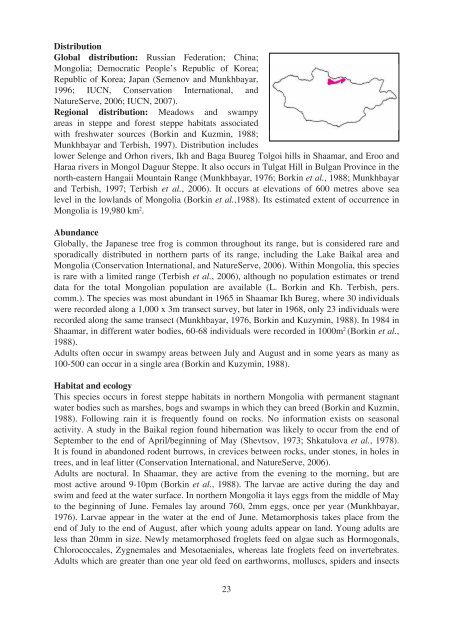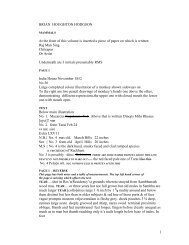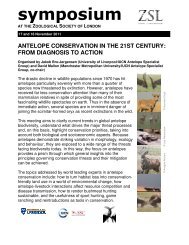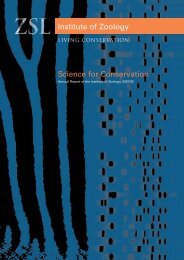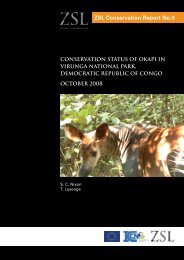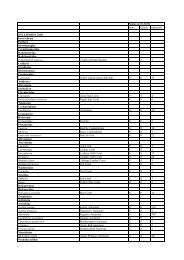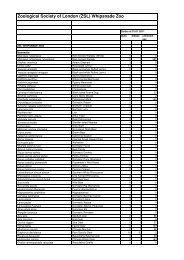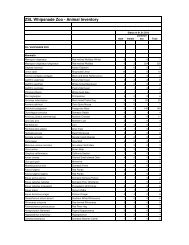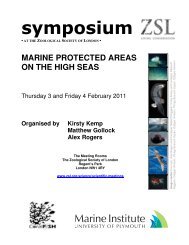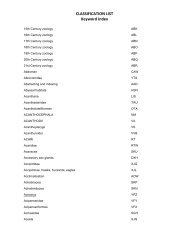Summary Conservation Action Plans for Mongolian Reptiles and ...
Summary Conservation Action Plans for Mongolian Reptiles and ...
Summary Conservation Action Plans for Mongolian Reptiles and ...
You also want an ePaper? Increase the reach of your titles
YUMPU automatically turns print PDFs into web optimized ePapers that Google loves.
Distribution<br />
Global distribution: Russian Federation; China;<br />
Mongolia; Democratic People’s Republic of Korea;<br />
Republic of Korea; Japan (Semenov <strong>and</strong> Munkhbayar,<br />
1996; IUCN, <strong>Conservation</strong> International, <strong>and</strong><br />
NatureServe, 2006; IUCN, 2007).<br />
Regional distribution: Meadows <strong>and</strong> swampy<br />
areas in steppe <strong>and</strong> <strong>for</strong>est steppe habitats associated<br />
with freshwater sources (Borkin <strong>and</strong> Kuzmin, 1988;<br />
Munkhbayar <strong>and</strong> Terbish, 1997). Distribution includes<br />
lower Selenge <strong>and</strong> Orhon rivers, Ikh <strong>and</strong> Baga Buureg Tolgoi hills in Shaamar, <strong>and</strong> Eroo <strong>and</strong><br />
Haraa rivers in Mongol Daguur Steppe. It also occurs in Tulgat Hill in Bulgan Province in the<br />
north-eastern Hangaii Mountain Range (Munkhbayar, 1976; Borkin et al., 1988; Munkhbayar<br />
<strong>and</strong> Terbish, 1997; Terbish et al., 2006). It occurs at elevations of 600 metres above sea<br />
level in the lowl<strong>and</strong>s of Mongolia (Borkin et al.,1988). Its estimated extent of occurrence in<br />
Mongolia is 19,980 km 2 .<br />
Abundance<br />
Globally, the Japanese tree frog is common throughout its range, but is considered rare <strong>and</strong><br />
sporadically distributed in northern parts of its range, including the Lake Baikal area <strong>and</strong><br />
Mongolia (<strong>Conservation</strong> International, <strong>and</strong> NatureServe, 2006). Within Mongolia, this species<br />
is rare with a limited range (Terbish et al., 2006), although no population estimates or trend<br />
data <strong>for</strong> the total <strong>Mongolian</strong> population are available (L. Borkin <strong>and</strong> Kh. Terbish, pers.<br />
comm.). The species was most abundant in 1965 in Shaamar Ikh Bureg, where 30 individuals<br />
were recorded along a 1,000 x 3m transect survey, but later in 1968, only 23 individuals were<br />
recorded along the same transect (Munkhbayar, 1976, Borkin <strong>and</strong> Kuzymin, 1988). In 1984 in<br />
Shaamar, in different water bodies, 60-68 individuals were recorded in 1000m 2 (Borkin et al.,<br />
1988).<br />
Adults often occur in swampy areas between July <strong>and</strong> August <strong>and</strong> in some years as many as<br />
100-500 can occur in a single area (Borkin <strong>and</strong> Kuzymin, 1988).<br />
Habitat <strong>and</strong> ecology<br />
This species occurs in <strong>for</strong>est steppe habitats in northern Mongolia with permanent stagnant<br />
water bodies such as marshes, bogs <strong>and</strong> swamps in which they can breed (Borkin <strong>and</strong> Kuzmin,<br />
1988). Following rain it is frequently found on rocks. No in<strong>for</strong>mation exists on seasonal<br />
activity. A study in the Baikal region found hibernation was likely to occur from the end of<br />
September to the end of April/beginning of May (Shevtsov, 1973; Shkatulova et al., 1978).<br />
It is found in ab<strong>and</strong>oned rodent burrows, in crevices between rocks, under stones, in holes in<br />
trees, <strong>and</strong> in leaf litter (<strong>Conservation</strong> International, <strong>and</strong> NatureServe, 2006).<br />
Adults are noctural. In Shaamar, they are active from the evening to the morning, but are<br />
most active around 9-10pm (Borkin et al., 1988). The larvae are active during the day <strong>and</strong><br />
swim <strong>and</strong> feed at the water surface. In northern Mongolia it lays eggs from the middle of May<br />
to the beginning of June. Females lay around 760, 2mm eggs, once per year (Munkhbayar,<br />
1976). Larvae appear in the water at the end of June. Metamorphosis takes place from the<br />
end of July to the end of August, after which young adults appear on l<strong>and</strong>. Young adults are<br />
less than 20mm in size. Newly metamorphosed froglets feed on algae such as Hormogonals,<br />
Chlorococcales, Zygnemales <strong>and</strong> Mesotaeniales, whereas late froglets feed on invertebrates.<br />
Adults which are greater than one year old feed on earthworms, molluscs, spiders <strong>and</strong> insects<br />
23


